// Video Surveillance
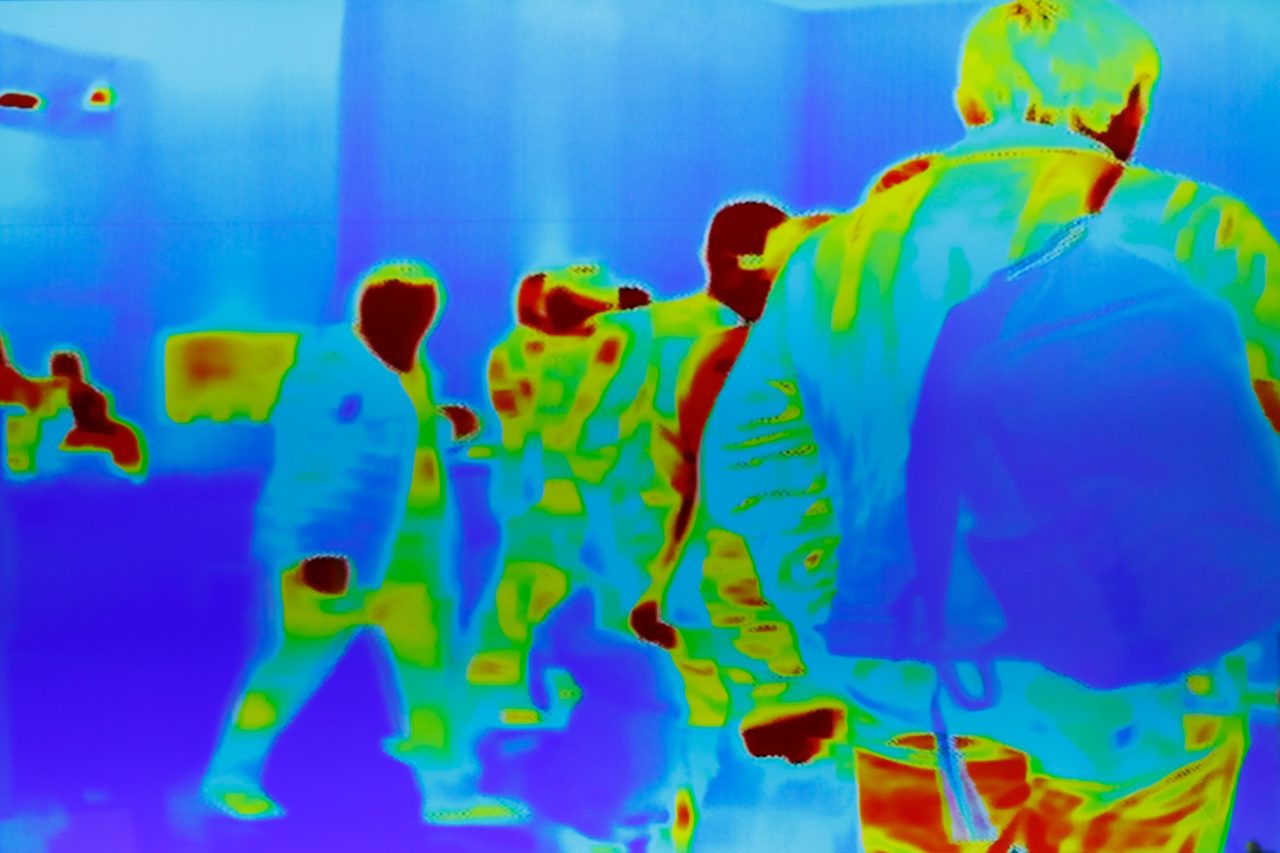
The Wide Appeal of
Thermal Cameras
Thermal cameras may not be the panacea of pandemic screening they were anticipated to be, but their rise in popularity has brought this valuable technology to the forefront in many other applications.
genkur/iStock / Getty Images Plus via Getty Images
The Wide Appeal of Thermal Cameras
The upshot of the interest in thermal cameras for health screening during the pandemic is that it raised awareness of thermal technology for use in a wider scope of applications.
By Laura Stepanek, SDM Contributing Writer
Thermal cameras have been an effective tool for security surveillance in low- and zero-light applications for decades. Then a pandemic comes along and guess which technology comes to the forefront for health-screening purposes, helping businesses to reopen safely? You got it: thermal.
Nearly two years later, and some health experts believe the pandemic is still raging while others think it is weakening. Regardless, when it comes to businesses seeking thermal cameras for the purpose of screening people to detect elevated skin temperatures (EST) that could indicate a COVID-19 infection, the urgency to buy has certainly slowed, sources say.
Security integrator Jim DeStefano, senior vice president at Unlimited Technology Inc., Chester Springs, Pa. (SDM’s 2021 Systems Integrator of the Year), recently visited a healthcare facility where he says a few months ago they were using thermal cameras for screening everyone who came in. But now, although the camera and black box are still on the wall, the facility is not using them.
“I think that particular piece of it has waned with vaccinations coming out, but I think if this pandemic continues and we see another spike, it may come back into use again,” DeStefano says. “With vaccinations, people have gotten a little laxer in their use of the cameras, but from what I can see I think they’re keeping them in their arsenal.”
The frenzy of last year’s rush to implement thermal EST cameras had an unexpected result — it bolstered the interest level in thermal technology overall. The security industry is now seeing demand grow for installing thermal cameras in many different settings, both security and non-security.
“Thermal cameras have been widely recognized as an effective technology for perimeter intrusion detection and adoption has been growing for many years,” says Kai Moncino, global business development manager for security at Teledyne FLIR, Wilsonville, Ore. “An additional catalyst for growth has been increased awareness about the value of thermal technology as a tool to detect elevated skin temperature throughout the COVID-19 pandemic. As thermal became a trending technology for detecting elevated skin temperature, it drove interest in using thermal for other use cases — from security to industrial safety.”
Moncino believes thermal cameras have been advanced to the point of providing maximum return on investment and lowered total cost of ownership. Thus, they are now more accessible to industrial customers across a broader range of applications. For example, “We are seeing strong demand for thermal cameras across the critical infrastructure sector for perimeter security and outdoor intrusion detection applications,” he says.
Paul Garms, director of regional marketing – video systems, at Bosch Security Systems LLC, Fairport, N.Y., has also witnessed increased demand for thermal cameras over the past 12 months. It’s being driven by a need for long-range perimeter intrusion detection in markets including critical infrastructure, government sites, airports and borders. “The cameras can help secure areas with high-value assets to deter possible equipment damage or theft of materials, like copper,” Garms describes.
This Teledyne FLIR thermal security camera captures a view of intruders attempting to breach a perimeter by cutting the fence, in total darkness.
IMAGE COURTESY OF TELEDYNE FLIR
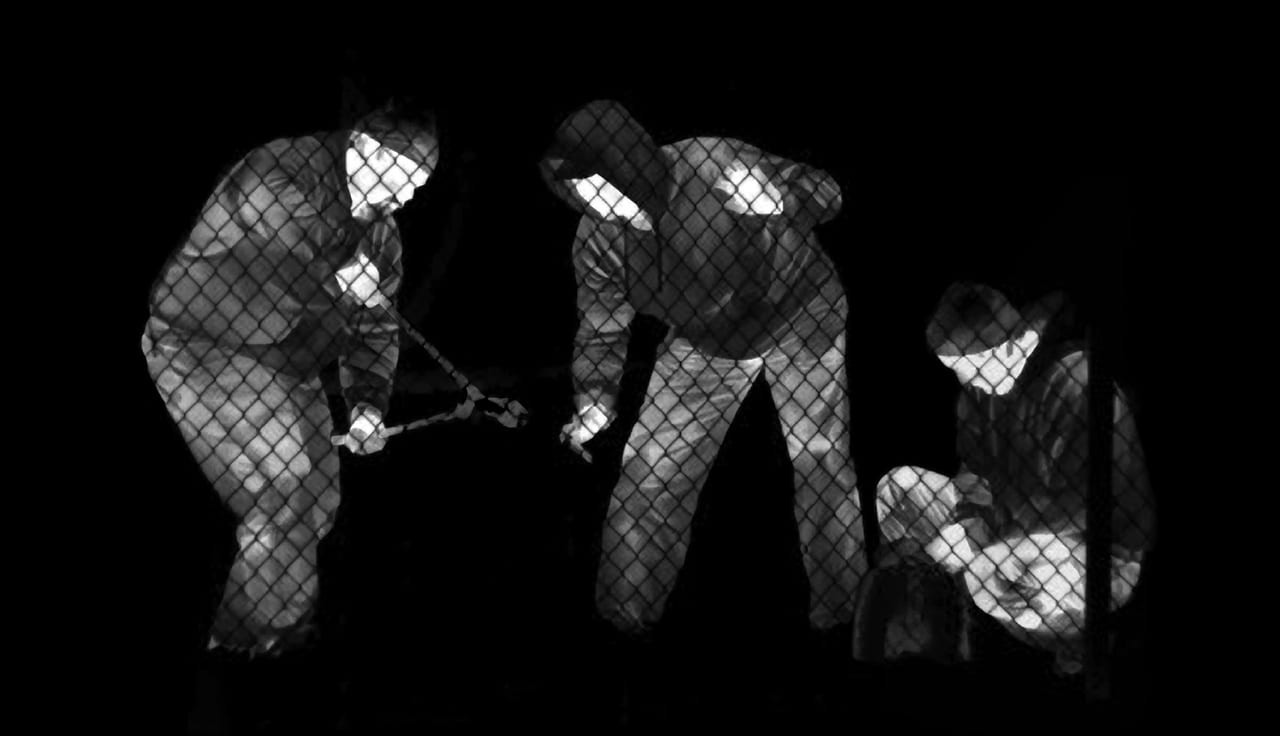
Demand remains high for thermal cameras for both traditional security and process monitoring applications, says Don Mannion, solutions engineer at Axis Communications, Chelmsford, Mass. Customers want a reliable way to detect and classify a person or vehicle after-hours in various settings including automotive dealerships, school athletic fields, boat marinas, high-end residential areas, and substations; as well as for applications such as flare monitoring, solar panel monitoring, and fire detection. “For installations of visual cameras, thermal cameras complement the existing solution and add certainty and peace of mind for the end user,” Mannion says.
Peace of mind for security end users is fundamental today, primarily due to conditions wrought by the pandemic, such as increased crime rates. “More people are working remotely and need visibility of what is happening in real time at all hours,” says Brad McMullen, general manager at 3xLOGIC, Fishers, Ind. “They need to know immediately if someone has breached a perimeter to trespass, cause damage or commit theft.”
And while the demand for thermal cameras for health screening may have slowed, some experts believe these cameras remain a viable solution as long as COVID-19 remains, and perhaps longer.
“Over the past year, demand for thermal devices for human temperature measurement has skyrocketed as a way of detecting elevated temperatures among people potentially experiencing symptoms such as a fever from COVID-19,” says Jennifer Hackenburg, product marketing director at Dahua Technology, Irvine, Calif. “Thermal devices became popular during the pandemic as a faster, more efficient, and non-invasive alternative to manual temperature measurement.”
Thermal cameras in the past were only considered for specific niche segments and industries; but today more industries are using them due to their ability to effectively detect people and objects 24/7 in both darkness and sunlight. For example, retailers are using thermal cameras to prevent theft in their logistic centers. In large parking lots they’re being used to detect people and vehicles in order to prevent theft of catalytic converters. Management companies are deploying thermal cameras on rooftops to avert HVAC theft. And prisons are using thermal cameras to avoid contraband issues, Mannion relates.
With so much active interest in the use of thermal technology, there has been corresponding activity in the cameras’ development — in the areas of perimeter security, industrial safety, health screening, and more.
Pandemic Creates Unique Use for Thermal Tech
In addition to selling thermal security cameras, security integrator Unlimited Technology Inc., Chester Springs, Pa., recently created a unique system using thermal sensors. Ceiling-mounted thermal sensors check signatures in a room to determine if the room is unoccupied for the purpose of disinfecting the room with UV lighting. The system is suitable for any type of facility in often-used rooms such as conference rooms, locker rooms or restrooms, and is particularly effective at keeping costs down in large buildings.
//
“With COVID-19 and the requirements for keeping places clean and sanitary, a lot of companies have resorted to personnel spraying down bathrooms with a disinfectant fog. But when you have multiple bathrooms in a facility it could be time-consuming, and there’s kind of a faith that the person is doing their job and actually spraying the whole room versus opening the door, spraying some sanitizer and then walking out,” says Jim DeStefano at Unlimited Technology.
His company takes a different approach, using UV lighting instead of disinfectant spray. The system integrates the UV lighting with thermal sensors to determine room occupancy, door locks and timers.
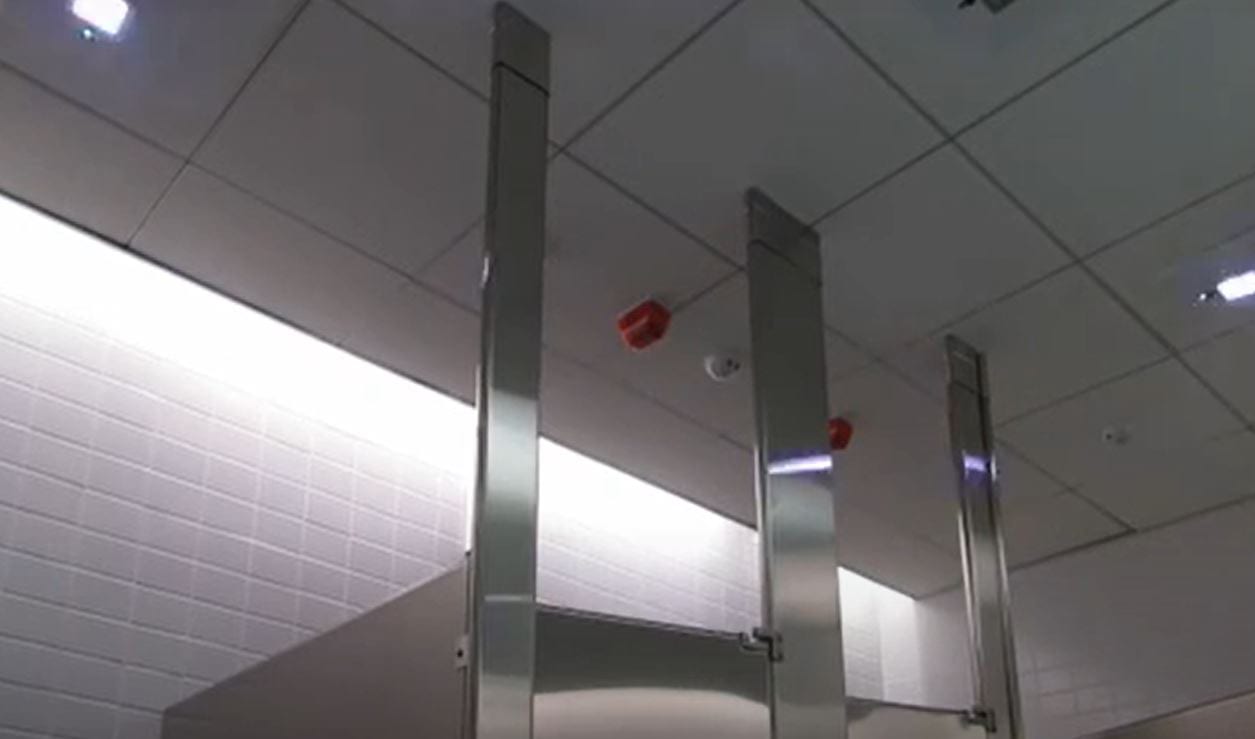
Security integrator Unlimited Technology Inc. created a room disinfectant system, which uses thermal sensors to ensure no one is in the room before the ultraviolet (UV) light-based disinfecting takes place. There are a number of different technologies in play in this solution, including timers and door locks.
IMAGE COURTESY OF UNLIMITED TECHNOLOGY INC.
He explains, “We can determine if there is somebody in the room using a detector — whether it’s a thermal detector, a heartbeat detector, or some other small detector. If there’s no detection of a human or an animal (no live being) in there, we can lock the door automatically. Then we start a timer, and with the timer we start a UV light that disinfects the entire room. Once the timer counts down, the light goes off, the door unlocks, and people can then use that bathroom or facility and know that it’s been disinfected.”
Unlimited Technology’s system is installed in several clients’ corporate office spaces, but DeStefano sees it being advantageous for other customers, as well.
Perimeter Security Developments
Thermal cameras play a major role in perimeter security applications because they’re intelligent, highly reliable, and integrate seamlessly with other devices and systems, Mannion explains.
“Thermal cameras are a big piece of the puzzle when it comes to perimeter security because customers want more than just the ability to detect movement — they want the ability to fully safeguard their sites from unwanted intruders,” he says. “Therefore, customers require a tool smart enough to detect people or vehicles while ignoring nuisance alarms like animals.
“But classification alone is not enough anymore; customers also want something that actively deters intruders by letting them know they are being watched. This means they need a solution where the equipment can communicate within the network. Accordingly, when a thermal camera classifies an object such as a person, a network audio speaker can automatically play an audio clip and send an alert to a mobile phone,” Mannion describes of solutions available from Axis.
Thermal cameras also are being integrated with radar for wide area monitoring, long-range detection, and earlier warnings of approaching threats, Teledyne FLIR’s Moncino relates. “We are seeing systems integrators reduce the cost and time of installing thermal cameras by deploying millimeter wave (mmWave) radios. By using wireless technology for communication infrastructure instead of trenching fiber cables, systems integrators can get the job done in days instead of months and with a significantly lower total installation cost,” he says.
A vast development in thermal camera technology is in the area of analytics for improved performance. When built with artificial intelligence, thermal cameras are yielding increased accuracy and fewer false alarms, Moncino says, specifically citing Teledyne FLIR’s advanced convolutional neural network (CNN) analytics.
The company offers an array of analytics, depending on the application. “Our security cameras deployed at data centers, substations and airports feature intrusion detection analytics such as line and area crossing, loitering, tampering and auto-tracking of threats. Our security cameras are also used for tank-level monitoring at oil and gas wells, while our specialized optical gas imaging thermal cameras are deployed for gas leak detection. Additionally, our intelligent traffic system cameras, installed in tunnels and bridges, detect accidents, wrong-way drivers, and fire,” Moncino describes.
Axis Communications’ analytics also vary by application. “For non-critical applications, AXIS Guard Suite is a complementary suite of applications, which includes AXIS Fence Guard, AXIS Motion Guard and AXIS Loitering Guard,” Mannion says. “For mission-critical applications, AXIS Perimeter Defender offers the classification of humans and vehicles using AI. This analytic draws upon various types of detection scenarios for intrusion detection, conditional zone crossing and loitering.”
Since the pandemic accelerated the remote-workplace trend, there is a greater need by end users to have visibility of what is happening in real time at their sites. Thermal cameras can provide immediate alerts of a person breaching a perimeter at any hour.
IMAGE COURTESY OF 3XLOGIC
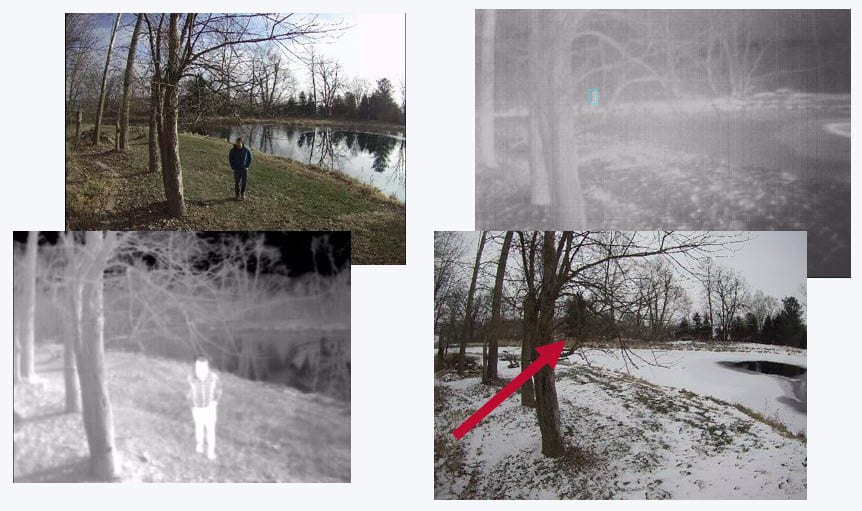
All of Bosch Security’s thermal cameras have built-in Intelligent Video Analytics, which reliably detects, tracks and analyzes moving objects while suppressing unwanted alarms, Garms says. “Advanced tasks like multiple line crossing, route following, loitering, idle and removed object detection are available, as well as object filtering based on size, speed, aspect ratio and more.”
The 3xLOGIC VX-VT Series Thermal Imagers have always included onboard analytics that allow for object classification, direction, people-counting, dwell times, and video alarm verification, McMullen explains. “They also feature temperature analytics to monitor threshold as well as slope rate notifications if a temperature is rising or falling within an assigned time period,” he explains.
Similar functionality is present in the analytics present in Dahua Technology’s thermal cameras. “Dahua cameras use several analytic functions such as fire detection, which detects a rise in temperature over a short time and issues an alarm for a potential fire; cold/hot spot trace to determine the coldest and hottest spot of the scene; smoking detection to alert if a person is smoking; and tripwire or intrusion with human and vehicle classification detection,” Hackenburg describes.
Industrial Safety Developments
In industrial settings, the use of thermal cameras for process monitoring continues to expand, Axis Communications’ Mannion says. This includes monitoring conditions such as temperatures in data centers, production issues with solar panels, leak detection in oils fields, and the temperature of switching gears or transformers at electrical substations, he describes.
Highly radiometric thermal cameras that deliver continuous, non-contact temperature measurement, are being deployed for predictive maintenance and condition monitoring at substations to monitor transformers and other mission-critical equipment, Moncino says. “Traditionally, thermographers, during regularly scheduled maintenance visits, would inspect equipment with a handheld thermal camera. Today, we are seeing the industry shift toward installing fixed radiometric cameras for 24/7 monitoring so that temperature data can be collected and analyzed over time. This data is used for trend reporting and to predict and prevent failure prior to equipment burnout,” he says.
Moncino thinks the heightened demand for fixed radiometric cameras presents new business opportunities for security integrators who are uniquely positioned to install these complex, outdoor networked systems.
Another opportunity for thermal cameras in the industrial world is tripwire alerts, Hackenburg describes, “For dangerous areas where someone could get hurt, such as at construction sites, lagoons and lakes, or on sections of highways where pedestrians are not allowed.”
Health-Screening Developments
At this uncertain time in the pandemic, one of the big questions on the minds of security integrators is whether there is still a need for thermal-based elevated skin temperature (EST) cameras and if so, will the need be short-term or long-term. According to several manufacturers, there is still a practical market for them.
“Due to the latest COVID-19 variant, these solutions are still viable health-screening options as long as [they follow] CDC thermal screening guidelines,” Hackenburg says. “However, the overall demand has decreased as compared to the height of the pandemic when most manufacturers couldn’t keep them in stock..”
Moncino also sees EST cameras as a long-term solution, precisely because elevated temperatures are a trait of other illnesses besides COVID-19.
“As the COVID-19 pandemic subsides, large enterprises are looking to incorporate elevated skin temperature cameras into their long-term business operations as well as environmental, health and safety plans,” he says. “This includes integrating fixed versions of these cameras into overall physical security systems. In other scenarios, companies are looking to install elevated skin temperature cameras as frontline screening tools during peak influenza seasons to better protect the health of staff and visitors as well as curb influenza transmission.”
Garms at Bosch Security notes that although demand for these solutions is decreasing, they can still provide value when used at checkpoints in places such as office buildings, manufacturing plants, and airports as part of a comprehensive approach. Thermal cameras designed for health screening can assist companies in taking the right predictive measures to safeguard people’s health and minimize illness spread, he says.
Human skin temperature detection solutions should not be relied upon as the only method of reducing risk, however, Garms notes. “They should be implemented as part of a layered approach with other security technologies, such as video analytics and data aggregation software tools for managing occupancy and ensuring social distancing, and access control for assisting with contact tracing.”
As an example, Unlimited Technology has deployed some cameras for customers that incorporate both thermal detection and mask detection in one unit. “The advantages there are that they can turn the thermal off if they need to and just screen for masks, or they can just screen for temperatures,” DeStefano says.
A thermal camera with video analytics can classify human or vehicular intrusions, resulting in fewer false alarms. The Teledyne FLIR Elara FC-Series ID camera with onboard analytics, shown here, detects humans walking along the perimeter of a property.
IMAGE COURTESY OF TELEDYNE FLIR
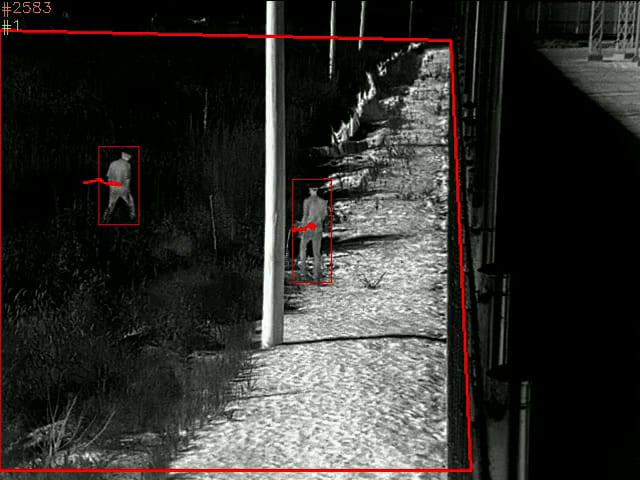
McMullen of 3xLOGIC thinks because the pandemic is a continually unfolding event that is creating a still-developing market, it is unclear if there will be a long-term need for these solutions. “Additionally, the accuracy, privacy and certification of such technologies are still being investigated,” he says.
Mannion refers to the debate that has been going on throughout the pandemic about the use of thermal cameras to detect fever and screen for COVID-19. “It’s important to note that most thermal cameras are not designed or intended for fever detection nor the diagnosis, mitigation or prevention of disease. In the U.S., this designation requires FDA approval.
“That said, under specific conditions, some thermal cameras can be precise, but environmental factors can affect accuracy, especially with long-range fever detection and mass screenings,” he says.
Overall, thermal cameras have become more precise and thus more useful for a wider variety of installations. Their cost has been greatly reduced, Hackenburg notes. “They shouldn’t be considered a niche camera like they’ve been in the past. A thermal camera should be the first type to be considered if the area to be viewed has challenging conditions, including thick underbrush, inclement weather, strong backlighting and complete darkness.”
Early generations of thermal cameras provided lower resolution images, which made it difficult to determine what was in the scene, according to McMullen. “There has been significant improvement in thermal sensor resolution so you can clearly see the image from the camera and determine if a human is present, and even identify characteristics of that person without the backup of a visible light camera,” he says. All leading to the conclusion that, combined with their built-in advanced analytics, thermal cameras have become a necessity for every security integrator’s inventory of security solutions. SDM

